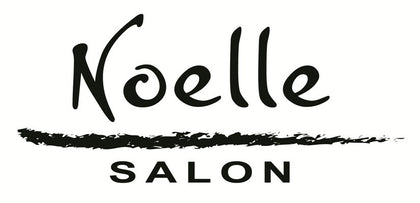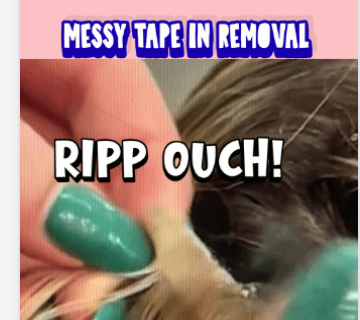Are Tape-In Hair Extensions Damaging Your Natural Hair? Why Veila Pull-Thru is a Safer Alternative

Key Highlights
-
Tape-in hair extension removal can be a damaging process, often leading to sticky residue and breakage for your natural hair.
-
The adhesive used in tape ins is the primary cause of potential harm, especially during the removal process.
-
Veila Pull-Thru extensions offer a safer, adhesive-free alternative that protects your hair quality.
-
Improper removal of tape-in extensions can contribute to hair loss and thinning, particularly for fine hair types.
-
Working with a professional stylist is the most effective way to apply and remove any type of extensions for the best results.
-
Proper care and choosing the right extension method are key to maintaining healthy hair.
Introduction
Tape-in hair extensions are a go-to for instant volume and length, but have you ever considered the toll they take on your natural hair? While many types of extensions exist, the hidden danger often lies in the removal process. The sticky adhesive can lead to breakage, leaving you with damaged strands. If you love extensions but prioritize your hair's health, it's crucial to understand these risks. With proper care and the right choice, you can enjoy beautiful, long locks without compromising your hair's integrity.
Understanding Tape-In Hair Extensions and Their Application
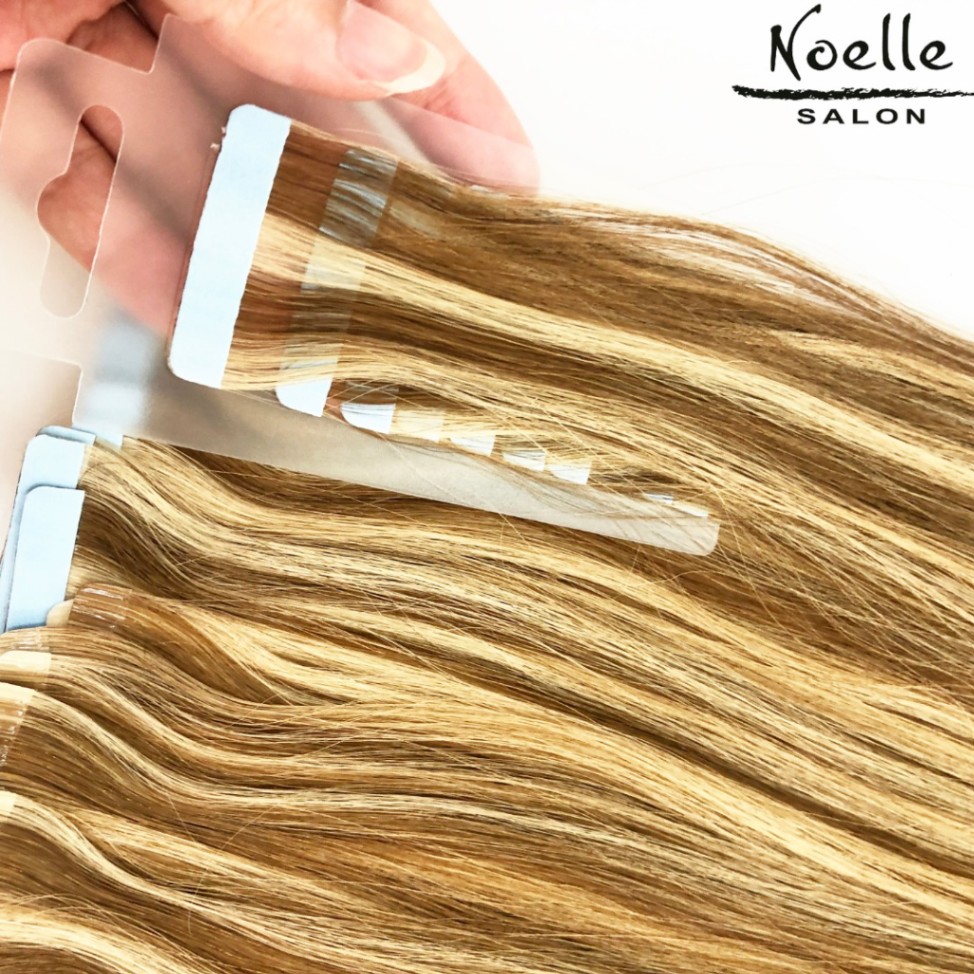
Tape-in extensions use wefts of human hair attached to a special hair tape. A professional stylist applies these by sandwiching small sections of your natural hair between two taped wefts. This method is popular because it's relatively quick and creates a flat, seamless look that blends with your own hair.
The goal is to add extra length and volume, enhancing your natural beauty without obvious attachment points. The hair color can be perfectly matched for a flawless finish. However, the success and safety of tape ins depend heavily on the application technique and your specific hair type. Next, we will cover how these extensions stick to the hair and why they are so popular.
How Tape-In Extensions Adhere to Natural Hair
The magic behind tape-in extensions is a strong, medical-grade adhesive on the hair tape. During application, a professional stylist takes a thin section of your natural hair and presses one taped weft underneath it and another on top. This creates a secure "sandwich" that holds the human hair extension in place. The bond is designed to be strong enough to last for weeks.
This secure attachment is what makes them reliable, but it’s also where the trouble can start. The adhesive bonds directly to your hair strands, which means the removal process must be handled carefully to avoid pulling or breaking your natural hair. If not done correctly, this can weaken your hair follicles over time.
Does removing tape-in hair extensions cause damage to your natural hair? Yes, it absolutely can. The adhesive can pull on your delicate strands during removal, leading to breakage and stress, especially if the bond is not properly dissolved.
Popularity of Tape-In Extensions for Volume and Length
It's no surprise that tape ins are a popular choice for anyone wanting a dramatic hair transformation. They offer a fantastic way to add extra length and significant volume in a single salon visit. The application process is much faster than fusion or sew-in methods, making it a convenient option for busy lifestyles. The wefts of hair lay flat against the head, creating a very natural look.
Another reason for their popularity is versatility. You can find tape-in extensions in a wide array of hair color options, allowing for perfect matching or even adding highlights without chemical processing. The lightweight feel of the hair tape makes them comfortable to wear daily.
However, this popular method comes with a catch. Can tape-in hair removal lead to hair breakage or thinning? Unfortunately, yes. The same adhesive that makes them secure can become a problem during removal, potentially causing the very thinning and breakage you were trying to mask.
Watch an Instagram Video Showing the difference between Pull-Thru and Tape-in Removal: https://www.instagram.com/p/DPzjwDKCvQk/
What Happens During Tape-In Extension Removal
The removal process for tape-in extensions is a delicate procedure that should ideally be handled by a professional stylist. It involves applying a special solution to the human hair tape to dissolve the adhesive. Once the bond is loosened, the wefts can be gently separated and slid off the hair.
When done correctly, this process should be painless. However, if the wrong hair products are used or the technique is rushed, it can lead to that dreaded ripping sound, sticky residue, and damage to your hair. Let's look closer at the tools used and the risks involved.
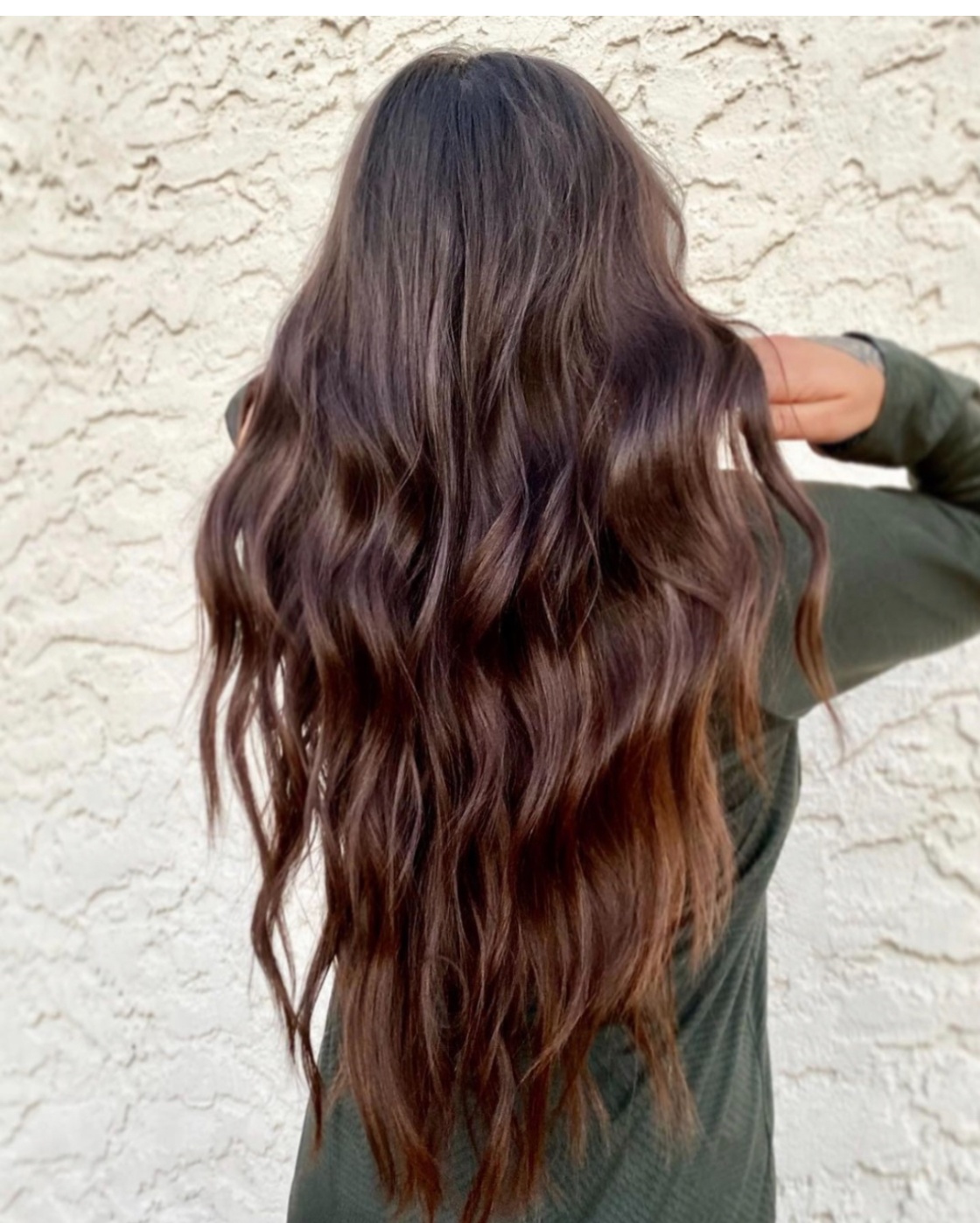
Typical Removal Techniques and Tools Used
To safely remove tape ins, a certified stylist will use specific tools and techniques. The primary goal is to break down the adhesive on the human hair tape without pulling on your natural hair. The process usually starts by saturating the tape bonds with a specially formulated remover solution.
This solution is typically oil or alcohol-based and works to dissolve the glue. After letting it sit for a moment, the stylist will gently wiggle the wefts apart. If there is any resistance, more solution is applied. A pintail comb is often used to help separate the panels.
What is the safest way to remove tape-in hair extensions to avoid hair damage? The safest removal process involves:
-
Using a quality, professional-grade bond remover.
-
Allowing the remover solution enough time to fully dissolve the adhesive.
-
Gently peeling the wefts apart, never pulling or forcing them.
-
Combing out any remaining residue before washing the hair.
Risks of Sticky Residue and Audible Tearing
One of the most frustrating parts of the tape-in removal process is the sticky residue left behind. This glue can be difficult to remove and may require harsh rubbing or additional chemicals, causing further stress to your hair and scalp. This lingering residue can also cause your hair to clump together, leading to tangles and breakage.
That awful, audible tearing sound during removal is a clear sign of damage. It means the hair tape is being pulled off without the adhesive being fully dissolved, ripping your natural hair strands along with it. This not only causes discomfort but can lead to immediate hair loss and weak spots.
Are certain hair types more prone to damage from tape-in extension removal? Absolutely. Those with fine, thin, or fragile hair are at a much higher risk. The delicate strands cannot withstand the tension and pulling from the tape ins, making breakage and damage more likely.
Common Signs of Hair Extension Breakage After Tape-In Removal
After removing tape ins, you might notice that your natural hair doesn't feel the same. The process can sometimes lead to visible hair extension breakage and other signs of distress. It's important to know what to look for so you can address the damage and begin the recovery process.
Noticeable thinning or short, broken hairs around the areas where the wefts were placed are common red flags. This type of damage can make your natural hair appear unhealthy and sparse. Below, we’ll outline the specific indicators of weakened strands and other visible symptoms you might see.
Indicators of Damaged or Weakened Strands
Once your tape-in extensions are out, take a close look at your natural hair. The signs of damage are often subtle but become more obvious upon inspection. Weakened strands may feel rough or brittle to the touch, and they might snap easily when you brush or style your hair.
The stress from the hair tape and removal can weaken the hair follicles, leading to thinning over time. You may notice your hair lacks its previous density, especially around the mid-lengths where the extensions were attached. This type of damage is a direct result of the tension and adhesive used.
Are there visible signs of hair damage caused by tape-in removal? Yes, there are several clear indicators to watch for:
-
Short, flyaway hairs around the scalp, indicating breakage.
-
A noticeable decrease in your hair's overall volume.
-
White dots on the hair shaft, which are a sign of stress fractures in the strand.
Visible Symptoms: Thinning, Dryness, and Split Ends
How do I know if tape-in extensions have already damaged my hair after removal? Look for three key symptoms: thinning, dryness, and split ends. Thinning is often most apparent when you put your hair in a ponytail and notice it feels less full than before. This happens when strands break off at the point of attachment.
Dryness is another common issue. The panels of the extensions can prevent natural oils from your scalp from traveling down the hair shaft, leaving your hair parched and brittle. After removal, your hair might feel like straw and look dull due to a lack of moisture.
Finally, check your ends. Damaged hair is prone to splitting, and you may see an increase in split ends throughout your hair, not just at the bottom. Without proper care to restore moisture and strength, these symptoms can persist long after the extensions are gone.
Factors That Make Some Hair Types Vulnerable to Tape-In Damage
Not all hair is created equal, and some hair types are more susceptible to damage from tape-in extensions. If you have thin hair or fragile hair, the weight and adhesive of the wefts can be too much for your strands to handle. The tension can easily lead to breakage and even hair loss.
A professional stylist can assess your hair type and density to determine if you are a good candidate. However, even with perfect application, certain hair characteristics inherently increase the risk. We'll explore why fine hair requires special consideration and how repeated use can cause cumulative damage.
Fine, Fragile, or Previously Treated Hair Considerations
If you have thin hair, each strand has a smaller diameter, making it naturally weaker and more prone to snapping. The weight of human hair extensions, combined with the strong adhesive, can put excessive strain on these delicate strands. This makes fine and fragile hair particularly vulnerable during the removal process.
Hair that has been previously treated with bleach or hair color is also at higher risk. Chemical processes compromise the hair's cuticle, leaving it more porous and fragile. Adding tape-in extensions to already weakened hair is a recipe for breakage, as the strands lack the structural integrity to support the extra weight and adhesive.
Are certain hair types more prone to damage from tape-in extension removal? Yes, especially these:
-
Fine or thin hair: Cannot support the weight and tension.
-
Chemically treated hair: Already weakened from bleach or color.
-
Naturally dry or brittle hair: Lacks the elasticity to resist pulling.
Effects of Repeated Tape-In Extension Application and Removal
Does repeated application and removal of tape-in extensions increase the risk of damage? Without a doubt. Each cycle of application and removal puts your hair through a stressful process. Even with perfect technique, some level of strain is unavoidable. Over time, this cumulative stress weakens your hair.
With every reapplication, the hair tape is placed on the hair, and a chemical solution is used to remove it. This repeated exposure can strip the hair's natural oils and degrade its protective cuticle, leading to chronic dryness and breakage. Your hair health can decline with each new set of tape ins.
Eventually, this cycle can cause significant thinning and make it difficult for your hair to recover. To avoid further damage, it's essential to give your hair long breaks between installations or consider a less damaging extension method altogether.
Minimizing Harm with Tape-In Extensions: Best Practices
If you decide tape-in extensions are still the right choice for you, following best practices is essential to protect your hair quality. Proper care starts with professional installation and continues with a dedicated maintenance routine at home. Using the right hair products is key to achieving the best results and minimizing damage.
The most critical step is having them removed by a professional stylist who knows how to handle your hair with care. Below, we'll discuss the best products and techniques for safe removal and compare the outcomes of professional service versus attempting it yourself.
Products and Techniques for Safe Tape-In Removal
What products help minimize damage when taking out tape-in extensions? The right products are crucial for a safe removal process. A high-quality, oil-based adhesive remover is your best friend. It gently breaks down the bond without requiring you to pull or tug on the hair. Avoid alcohol-based removers, as they can be extremely drying.
After the wefts are out, your hair will need some TLC. Use a clarifying shampoo to wash away any leftover residue, followed by a deep conditioner to restore moisture. Leave-in conditioners and serums can also help replenish dry, stressed strands. Proper care immediately after removal is key to recovery.
A professional stylist will have access to the best products and know the correct techniques. For safe removal, they will:
-
Apply a generous amount of bond remover and let it sit.
-
Use the tail of a comb to gently separate the wefts.
-
Slide the extensions down the hair shaft instead of pulling them off.
-
Recommend follow-up treatments to nourish your hair.
Professional Versus DIY Tape-In Removal Methods
Is professional tape-in extension removal less damaging than DIY methods? Yes, by a significant margin. A professional stylist or hair extension expert has the training, experience, and proper tools to remove extensions safely. They know how to assess your hair's condition and apply the remover solution precisely to minimize contact with your scalp and surrounding hair.
Attempting a DIY removal is incredibly risky. You might not be able to see the back of your head clearly, leading to improper application of hair products and aggressive pulling. Many people who try at-home removal end up with significant breakage, bald patches, or a sticky, matted mess that requires a corrective salon visit anyway.
Regular salon visits for maintenance and removal are non-negotiable for healthy extensions. A professional can spot early signs of tension or damage and address them immediately. Saving a few dollars on a DIY removal isn't worth risking the health of your hair.
Why Veila Pull-Thru Hair Extensions Are a Safer Alternative
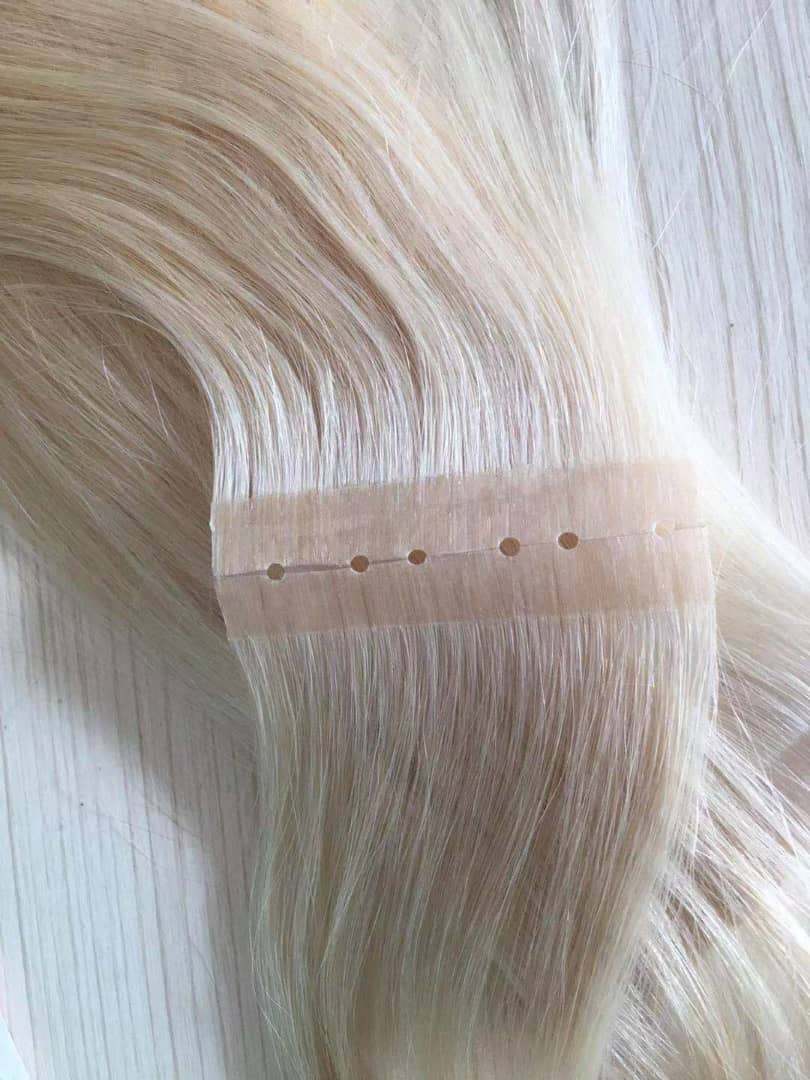
Ready to try Pull-Thru Extensions? Shop Veila Now
If you're worried about the damage from tape-ins, there's good news. Veila Pull-Thru hair extensions are an excellent option that prioritizes your hair health. This innovative method is an effective way to get the length and volume you want without any of the sticky, damaging adhesives.
This system is gentle on all hair types, including fine and fragile hair. Because it avoids glue and tape entirely, the removal process is simple, clean, and completely damage-free. Let's look at how this method works and why it's a superior choice for long-term hair health.
How Pull Thru Hair Extensions Avoid Adhesive Damage
Veila Pull-Thru hair extensions use a revolutionary bead-based system that completely eliminates the need for tape, glue, or heat. The weft of hair has small openings at the top. Your natural hair is pulled through these openings using a special tool and then secured with a tiny, silicone-lined bead.
This method attaches the weft without any sticky substances touching your hair. The bead is simply clamped down to hold the hair in place. Because there is no adhesive, your natural hair is not coated in chemicals, and there is no risk of it being pulled out during removal. This focus on hair health is what sets the system apart.
What makes Veila Pull-Thru extensions safer than tape-ins for delicate hair? The absence of adhesive means there is no pulling, tearing, or chemical residue. The removal process is as simple as unclamping the bead, allowing the weft to slide out effortlessly and leaving your delicate hair completely unharmed.
Benefits of Bead-Based Pull-Thru Method for Hair Health
The bead-based application of Veila Pull-Thru extensions offers numerous benefits for your hair quality. Since there's no glue, the removal process is incredibly clean. You won’t have to deal with sticky residue that requires harsh scrubbing to remove, which helps preserve the integrity of your hair. This directly answers the question, "Does removing tape-in hair extensions cause damage to natural hair?" by providing an alternative where the answer is no.
This method also promotes healthy hair growth. Your scalp can breathe, and your natural hair isn't sealed between two tape panels. With proper care from a professional hairstylist, the extensions can be moved up every few weeks without causing any stress or breakage, allowing your own hair to grow strong underneath.
The key benefits for hair health include:
-
No adhesive damage: The bead-based system is free of glue and tape.
-
Easy and clean removal: No sticky residue or painful pulling.
-
Reusability: The same hair can be reused for up to a year, making it a sustainable and gentle option.
Pull-Thru vs. Tape-In: Side-by-Side Comparison
When choosing between tape ins and Veila Pull-Thru hair extensions, a direct comparison makes the superior choice clear. While both use high-quality human hair to enhance your look, their impact on your hair health differs dramatically. Pull-thru extensions are designed with the long-term integrity of your hair in mind.
Proper care is easier with a system that doesn't involve adhesives. Here is a quick look at how the two methods stack up against each other, especially concerning hair quality.
|
Feature |
Tape-In Extensions |
Veila Pull-Thru Extensions |
|---|---|---|
|
Application Method |
Adhesive tape sandwiches natural hair. |
Natural hair is pulled through a weft and secured with a bead. |
|
Removal Process |
Requires a chemical solvent to dissolve glue. |
Beads are simply unclamped for the weft to slide out. |
|
Risk of Damage |
High risk of breakage and thinning from adhesive and pulling. |
Virtually no risk of damage; no glue or tension. |
|
Residue |
Often leaves a sticky residue that is hard to remove. |
No residue at all, leaving hair clean. |
|
Suitability for Fine Hair |
Risky; weight and adhesive can cause breakage. |
Excellent; lightweight and gentle on delicate strands. |
Removal Experience: No Residue, No Breakage
The removal experience is one of the biggest differences between these two methods. With tape-ins, there's always a risk of discomfort and damage. The chemical removers can be harsh, and if the technician is not careful, the process can cause significant breakage. Many clients report leaving the salon with sticky residue in their hair that takes days to wash out.
In contrast, removing Veila Pull-Thru extensions is a completely clean and painless process. The stylist uses a special tool to gently open the microbeads, and the weft slides right off. There is no pulling, no chemicals, and absolutely no residue left behind. Your hair is in the same healthy condition it was in before the extensions were applied.
This stress-free removal is a game-changer for hair health. By avoiding the adhesive and harsh solvents used for tape-ins, you eliminate the primary cause of extension-related damage. This ensures your natural hair remains strong and intact, appointment after appointment.
Maintenance, Longevity, and Suitability for Sensitive Hair
When it comes to maintenance, Veila Pull-Thru extensions are designed for longevity and ease. Because the hair is not damaged by adhesive, the wefts can be reused for up to a year with proper care. This makes them a more sustainable and cost-effective choice over time. Regular salon visits are simple "move-up" appointments where the beads are loosened and repositioned closer to the scalp.
Tape-ins, on the other hand, require complete removal and re-taping at each maintenance appointment, which adds to the cumulative damage. The potential for thinning and breakage from tape-in removal makes them a poor choice for anyone with sensitive hair or a delicate scalp.
Veila Pull-Thru extensions are ideal for every hair type, especially those concerned about damage.
-
Longevity: Hair is reusable for up to a year, unlike tape-ins which degrade faster.
-
Maintenance: Simple move-up appointments without harsh chemicals.
-
Suitability: The perfect, gentle solution for fine, fragile, or sensitive hair.
Helping Your Hair Recover After Tape-In Extensions
If you've already experienced damage from tape-in extensions, don't worry—your hair can bounce back. The key to hair recovery is a combination of gentle handling, nourishing hair products, and patience. Focusing on proper care can help restore your hair health and encourage strong new hair growth.
It's time to give your hair a break from harsh treatments and focus on rebuilding its strength and moisture. Read on for some essential care tips to help your natural hair recover and advice on when it might be time to consult a professional.
Care Tips to Strengthen Natural Hair Post-Removal
What steps should I take after tape-in removal to help my hair recover? First, focus on restoring moisture. Use a sulfate-free, hydrating shampoo and follow up with a deep conditioner or hair mask at least once a week. Let the conditioner sit for several minutes to allow it to penetrate the hair shaft and replenish lost moisture.
Next, minimize heat styling. Give your flat iron and curling wand a rest. If you must use heat, always apply a quality heat protectant spray to shield your fragile strands. Air-drying your hair is the best option for promoting a healthy hair recovery. Gentle brushing and avoiding tight hairstyles will also prevent further breakage.
To get your hair back on track, follow these proper care tips:
-
Use moisturizing hair products, including deep conditioners and leave-in treatments.
-
Massage your scalp to stimulate blood flow and encourage new growth.
-
Be gentle when brushing and detangling your hair.
-
Take a break from chemical treatments like coloring or bleaching.
When to Seek Professional Guidance for Damaged Hair
If you notice significant hair loss, thinning patches, or severe breakage after removing tape-in extensions, it's time to book a consultation with a professional stylist. While some minor damage can be managed at home, extensive issues require an expert eye. A stylist can assess the extent of the damaged hair and create a personalized recovery plan.
How do I know if my hair is damaged beyond a quick fix? If your hair feels gummy when wet, snaps with the slightest touch, or if you see bald spots, professional help is necessary. These are signs that the hair's structure is compromised. For those with severe hair loss or conditions like trichotillomania, a hair extension expert can discuss specialized solutions.
Don't wait for the problem to worsen. A professional can recommend restorative treatments, a corrective haircut to remove split ends, or even suggest safer alternatives for the future, such as mesh integration systems that are designed for clients with significant hair loss.
Conclusion
In conclusion, while tape-in hair extensions offer a quick and attractive way to achieve length and volume, the potential damage during their removal cannot be overlooked. Many users experience issues like sticky residue, breakage, and weakened strands, particularly those with fine or previously treated hair. Thankfully, alternatives like Veila Pull-Thru extensions provide a gentler solution that eliminates adhesive concerns, ensuring a healthier experience for your natural hair. By considering your hair's unique needs and choosing the right extension method, you can enjoy beautiful, voluminous locks without sacrificing hair health. If you're interested in exploring safe application techniques or need personalized advice, don't hesitate to get a free consultation with our experts today!
Frequently Asked Questions
Can tape-in hair extension removal cause lasting hair breakage or thinning?
Yes, improper or repeated removal of tape ins can lead to lasting damage. The adhesive can weaken hair, causing breakage and thinning. If the strain on the follicles is severe, it can result in hair loss over time, especially for those with fine hair. Professional handling of the removal process is critical to minimize these risks.
What makes Veila Pull-Thru extensions safer than tape-ins for delicate hair?
Veila Pull-Thru extensions are safer because they use a bead-based system with no adhesive, glue, or heat. This eliminates the risk of breakage and residue associated with tape-ins. The gentle application and removal make them ideal for protecting the hair health of delicate or fine hair types, and maintenance is damage-free.
How do I know if my natural hair is damaged after removing tape-in extensions?
Look for visible signs of hair damage like increased breakage, split ends, and a brittle, dry hair texture. You might also notice that your ponytail feels thinner or see short, broken flyaways near your roots. If your natural hair feels significantly weaker or looks less dense, it has likely sustained damage.
